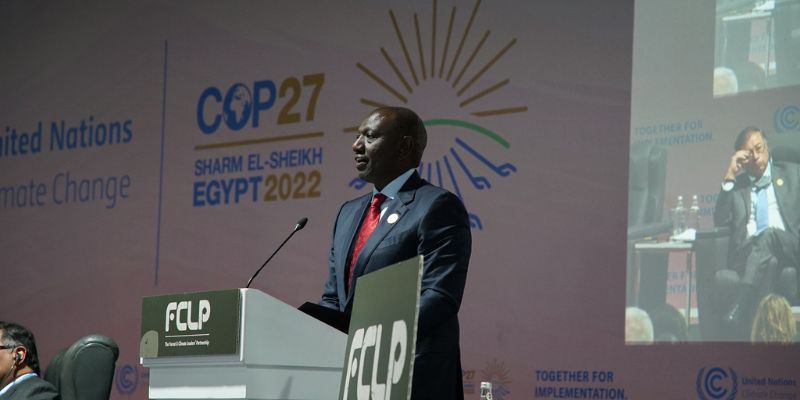Contradictions big and small
In December 2022, Ruto declared that Kenya would plant 15 billion trees by 2032. Just a few months later, he lifted a logging ban that he put in place as Deputy President in 2018. Introduced to protect shrinking mountain forests that are key water sources, a task force was convened to investigate mismanagement by the Kenya Forest Service (KFS). Their recommendations, including the reform of KFS, were never implemented. This calls into question Ruto’s motive for lifting the ban, in particular, because it will likely reverse the gains in tree cover made in recent years. This will exacerbate the drought in Kenya, threatening an already fragile food and water supply. It will also reduce hydropower generation.
The problem with tree planting programs is that without a sophisticated design that prioritizes natural forest regrowth and ecological restoration over tree plantations and false metrics like the number of trees planted, they often do more harm than good. Planting the wrong trees in the wrong places can reduce biodiversity, accelerating extinctions and impairing ecosystems’ resilience. Trees also struggle to survive in the wrong environment, and even disturb the soil, releasing carbon instead of storing it. This is particularly true in drylands like those found in most of Kenya, where tree planting can also devastate wildlife.
More obviously, a large proportion of seedlings often die before reaching maturity. With no details on what tree species will be planted where, how sufficient seeds will be sourced, how they will be grown to maturity, or how they will be monitored and protected, planting 15 billion trees is just another of Ruto’s hustles.
Ruto’s Minister of Environment, Climate Change and Forestry, Soipan Tuya, told every Kenyan to plant 30 trees per year toward the goal of 15 billion. Without any resources or plan to support mass tree planting by all citizens, this is worse than hollow nonsense—it’s a show to distract from the lack of any meaningful plan for reforestation or other ecological restoration. In an even more transparently empty performance, Tuya admonished Kenyans not to cut trees for Christmas.
Ruto has long used his farmer roots to portray himself as the everyman. A large landowner heavily invested in farming businesses, his embrace of climate-smart agriculture will undoubtedly enrich him at the expense of most farmers. Climate-smart agriculture is an opaque term that co-opts regenerative practices from sustainable agriculture and agroecology while using the climate emergency as justification to depoliticize those practices and empower industrial-scale approaches that favor big agribusiness. It has been heavily criticized for having no enforceable social or environmental criteria, leading to wildly different uses of the term. This lets big agribusiness label themselves as climate-smart by simply doing things like selling drought-tolerant seeds, despite industrial agriculture’s major contribution to greenhouse gas emissions globally. Climate-smart agriculture provides a greenwashed avenue for industrializing agriculture in Africa, which would likely increase emissions and make smallholder farmers more vulnerable.
Climate-smart agriculture also does nothing to address pressing issues for smallholder farmers such as land tenure, scarcity of arable land, or lack of capital to invest in expensive “climate-smart” technologies. Bigholder farmers with large capital reserves like Ruto, of course, will benefit from increased mechanization and input-intensive cultivation at the expense of smallholder farmers who are the least responsible for agricultural emissions. Smallholder farmers, comprising the majority of Africans today, would instead benefit from tried-and-true agroecological practices that support climate-resilient agriculture from the soil up.
Proponents of climate-smart agriculture believe that expensive technologies and inputs can be partly financed by carbon offset schemes. Instead of supporting smallholder farmers, this would create market pressures to consolidate larger tracts of land to facilitate economies of scale for carbon trading, creating incentives for land grabbing and coercion while unfairly putting the burden of climate mitigation on the least culpable but most vulnerable.
Ruto has pledged to phase out fossil fuels by 2030. He often starts this story by talking about how 90 percent of Kenya’s energy is renewable. Unlike other African leaders whose economies are dependent on fossil fuel extraction, Ruto can promote himself by talking about Kenya’s existing renewable energy production. But, this is a disingenuous story. As Murefu Barasa from EED Advisory said at our recent dialogue on climate emergencies in Africa, Kenya’s grid-based electricity is 90 percent renewable, not its total energy use. Electricity makes up only 12 to 15 percent of national energy use. 65 percent comes from biomass (firewood and charcoal), most of which is non-renewable. Petroleum makes up 20 percent and the remaining five percent is from other sources.
This dubious renewables story is further compromised by Kenya’s dependence on hydropower. Hydro is the second largest source of electricity generation after geothermal, making up about one-third of the total mix. The increasing prevalence of droughts severely undermines hydropower. Ruto’s story also does not account for the rapid increase in energy demand or high population growth. Finally, one-quarter of the population does not even have access to the grid to make use of electricity, renewable or otherwise. In this story, Ruto rarely talks about fossil fuels despite committing to build a 600km gas pipeline from Dar es Salaam to Nairobi. What does this doublespeak mean for his pledge to phase out fossil fuels? The media has been oddly silent on the matter.
To much fanfare, Ruto drove a bright yellow electric car to the Africa Climate Summit. If he had wanted to make a more meaningful statement and stand with the average Kenyan, you have to wonder why he did not make the easy 30-minute walk from the State House to the convention center. Perhaps because infrastructure to protect pedestrians is negligible in Nairobi. While more than 80 percent of Kenyans in cities walk and take public transit, and private vehicle ownership is rare, Ruto is prioritizing electric vehicle adoption and EV charging infrastructure over more equitable and low-emission options like walking, bicycling, and public transit.
In a similar stunt a few months earlier, the First Lady Rachael Ruto cycled from the State House to the UN-Habitat Assembly. While she showed up her husband by cycling instead of driving, she was surrounded by security vehicles, affording her protections that other cyclists do not have. Nairobi does not have cycling lanes. Neither her initiative, Mama Cycling, nor her husband’s policies include investments in cycling lanes or other critical safety infrastructure for cyclists. She returned to the State House in a car.
The green growth lie
In his latest costume change, Ruto has transformed himself into the go-to African climate champion. His previous climate contradictions are small in comparison to his embrace of climate positivism, carbon markets, and win-win green growth. Watch as his power and wealth grow.
Piggybacking on other leaders, Ruto has called for sorely needed reform of the international financial system and multilateral development banks, as well as debt relief and pauses. He has even called for global carbon taxes and the establishment of a new green bank. These are crucial but notably incomplete pieces of the puzzle.
Using the legitimacy that selectively criticizing European and American institutions lends him, he has shrewdly but disingenuously positioned himself as the pan-African climate leader and anointed himself as the African spokesperson for green growth. At the same time, in a clever sleight-of-hand, he has abandoned the consensus on common but differentiated responsibilities, calling it the blame game and letting polluters off the hook. Demanding accountability for historical responsibilities is not victim-playing. This is a false, pernicious, and damaging narrative dressed up as pan-African leadership. Make no mistake, this is leadership for Ruto himself and the elite few alone.
In a troubling about-face, he dropped his support for a Loss and Damage Fund and said “we don’t want the North to pay, we all want to pay.” The subtext is that we just need better lending practices to solve the climate emergency. In other words, make markets more fair but don’t do anything else. The few beneficiaries of this greenwashed, business-as-usual approach are obvious. It is a betrayal of the great majority of Africans, especially the historically large youth population.
What are Ruto’s vehicles for solving the climate finance emergency? Carbon markets and green growth. These solutions are at best magical thinking. But, given his consistently self-serving record, it seems more like a cynical bid for more power and wealth than a genuine, if gullible, belief that ever more elaborate market fixes can solve fundamental market failures.
Ruto’s embrace of carbon markets at COP27 and the Africa Climate Summit 2023 is consistent with his agenda to promote market-based mechanisms while undermining a just transition. International carbon offset markets—especially voluntary, unregulated ones—are a fatally dangerous distraction. Since their inception at COP3 in 1997, a broad range of research from progressive and conservative government, academic and media organizations have amassed an alarmingly large and insurmountable mountain of evidence demonstrating that, while offsets tell a tempting story in theory, offsetting emissions in practice is impossible.
The fundamental problem—as Barbara Hayer, the director of the Berkeley Carbon Trading Project, recently told the New York Times—“is that you’re trading a known amount of emissions with an uncertain amount of emissions reductions. But there’s also the whole trading approach of companies being able to buy their way out of their responsibility to reduce their own emissions.” Efforts to fix offset’s flaws are too little too slowly. Genuine offsets that reduce emissions immediately and permanently are in fact antithetical to markets today—the global economy is too large, too complex, and too fragmented for offsets to ever be effectively regulated. Regulated in one location, polluters will always be able to move to other locations where they are not. Carbon credits, instead, offer polluters a license and incentive to keep polluting.
What does this mean for Africa? With Ruto’s leadership, the African Carbon Markets Initiative (ACMI) was launched at COP27 in Egypt. It aims to reach 300 million credits retired annually by 2030. With weak regulatory and enforcement frameworks across the continent, ACMI will suffer from the same, if not worse, issues as other voluntary carbon markets.
The ACMI will give major polluting countries and fossil fuel and other transnational companies new opportunities to increase their emissions while saying they are reducing them. Africa is the fastest-warming and most vulnerable continent so increased emissions will exacerbate already mounting climate impacts. It also creates perverse incentives that undermine resilient and inclusive development, enabling historical polluters to keep investing in carbon-intensive development elsewhere at the expense of development in Africa. At the same time, it also shifts responsibility for climate mitigation from big polluters to negligible ones.
Carbon offset projects incentivize tons of carbon reduced over local and regional development across crucial sectors. They also incentivize green land grabbing to develop projects like tree plantations and hydropower dams. At the end of the day, carbon offset projects may get less than one-third of the money paid by polluters for credits. The rest will go to middlemen like Ruto.
At the Africa Climate Summit in September, Ruto spoke of carbon markets interchangeably with climate finance, implying that they were one and the same for Africa. In fact, many critics said the Summit was little more than a trade conference for carbon credits. It featured both virtual and physical ‘deal rooms,’ exclusive spaces where investors and project developers could meet to cut deals. Carbon credits are not a substitute for, nor can they provide, adequate climate finance.
The 2023 Climate Change (Amendment) Bill to the 2016 Climate Change Act, rushed through the Kenyan Parliament with minimal due diligence or public participation in the lead-up to the African Climate Summit, was signed into law on September 1 by Ruto. While regulation of domestic carbon trading with stipulations for community benefit sharing is perhaps better than previously unregulated trading, it may also lend legitimacy to a deeply flawed solution.
While the Amendment does include stipulations for land-based vs non-land-based projects, it does nothing to address contentious issues of land tenure. A large amount of rural land in Kenya (and 90 percent across Africa) is undocumented and informally administered. The Bill’s inconsistency with the Community Land Act that governs the process for registering communally-owned land will put rural communities at risk of losing their land and being excluded from community benefit agreements. This will make the process prone to exploitation by middlemen who can take advantage of undocumented land ownership. Land dispossession puts communities’ livelihoods at risk and therefore impairs their climate resilience.
During the National Assembly proceedings on August 22, elected representatives debated the amendment. One MP alone, Ahmed Shakeel Ahmed Shabbir of Kisumu East, dissented. He said:
I have never seen this country develop anything out of carbon credits. It is the foreign consultants who in collusion with these Kenyan consultants take away our benefits from carbon credits. Our carbon credits are worth a lot of money. They take our carbon credits and throw them at the cost of nothing with foreign consultants. And they say, ‘you must allow us to do that, we are bringing benefit to Kenya.’ I have seen no benefit to Kenya. It is the same way the colonialists came here, they gave us cowry shells and took away our gold, they gave us cowry shells and took away our wealth. Now, they are giving us carbon credits and taking away our wealth.
Good lies contain partial truths. As Danny Cullenward of CarbonPlan said: Carbon offsets can work—“if you were to reinvent the entire industrial structure, focus on a subset of activities and accept prices that are massively higher than they are today.” Short of that, carbon markets are a convenient hustle for opportunists and middlemen because they sound so good in theory but so few people understand them in practice. They are an important thread in Ruto’s green growth lie, a lie he told well at the Africa Climate Summit where he made carbon credits synonymous with climate finance (more about this lie in part two).
–
This post is from a partnership between Africa Is a Country and The Elephant. We will be publishing a series of posts from their site every week.








